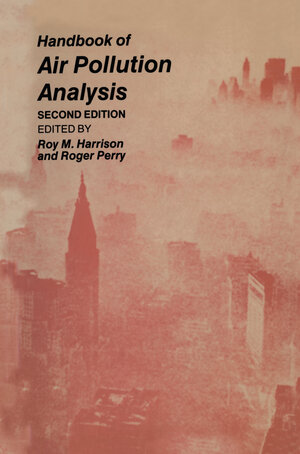
×
![Buchcover ISBN 9789400940833]()
Handbook of Air Pollution Analysis
herausgegeben von Roy M. HarrisonInhaltsverzeichnis
- 1 General sampling techniques.
- 1.1 Sampling goals and requirements.
- 1.2 Sampling methods.
- References.
- 2 Air pollution meteorology.
- 2.1 Introduction.
- 2.2 Meteorological measurements.
- 2.3 Outline of the more important features of the atmospheric transport and dispersion of pollutants.
- 2.4 Calculation of the atmospheric transmission of pollutants.
- 2.5 Examples of calculations using Gaussian models.
- 3 Air pollution chemistry.
- 3.1 Introduction.
- 3.2 Inorganic reactions.
- 3.3 Reactions involving organic compounds.
- 3.4 Gas-to-particle conversion.
- 3.5 Conclusion.
- 4 Analysis of particulate pollutants.
- 4.1 Introduction.
- 4.2 Suspended material.
- 4.3 Dustfall sampling.
- 4.4 Physical techniques for classification of particulates.
- 5 Metal analysis.
- 5.1 Introduction.
- 5.2 Analysis of particulate matter.
- 5.3 Gases and vapours.
- 6. Nitrogen and sulphur compounds.
- 6.1 Introduction.
- 6.2 Basic analytical techniques.
- 6.3 Experimental section.
- 6.4 Particulate compounds of S and N.
- 7 Secondary pollutants.
- 7.1 Introduction.
- 7.2 Basic analytical techniques for the analysis of gaseous secondary pollutants.
- 7.3 Experimental section.
- 8 Hydrocarbons and carbon monoxide.
- 8.1 Introduction.
- 8.2 Volatile hydrocarbons.
- 8.3 Hydrocarbon fraction of airborne particulate matter.
- 8.4 Carbon monoxide.
- 9 Halogen compounds.
- 9.1 Fluorides.
- 9.2 Chlorine.
- 9.3 HCl and particulate chloride.
- 9.4 Bromides.
- 9.5. Halogenated hydrocarbons.
- 10. Remote monitoring techniques.
- 10.1 Introduction.
- 10.2 Correlation spectroscopy.
- 10.3 Single wavelength lidar.
- 10.4 Differential lidar.
- 10.5 Laser safety.
- 10.6 Long pathlength absorption spectroscopy (this section by A. M. Winer).
- 10.7 Meteorological measurements.
- 10.8 The use of remote sensing in field studies.
- 10.9 Conclusions.
- Acknowledgements.
- 11. Physico-chemical speciation techniques for atmospheric particles.
- 11.1 Introduction.
- 11.2 Speciation methods.
- 12. Analysis of precipitation.
- 12.1 Introduction.
- 12.2 Sampling.
- 12.3 Analysis.
- 12.4 Concluding comment.
- 13. Low-cost methods for air pollution analysis.
- 13.1 Introduction.
- 13.2 General considerations.
- 13.3 Selected methods for measuring air pollutants.
- 13.4 Additional considerations for selecting a low-cost air pollution measurement method.
- 14 Planning and execution of an air pollution study.
- 14.1 Introduction.
- 14.2 Objectives of the monitoring programme.
- 14.3 Effluent history from source to receptor.
- 14.4 The monitoring network.
- 14.5 The design of pollution monitoring systems.
- 14.6 Data handling.
- 14.7 Analysis of results.
- 14.8 Examples of monitoring networks and data presentations.
- 15 Quality assurance in air pollution monitoring.
- 15.1 Quality and quality assurance.
- 15.2 Definitions.
- 15.3 Elements of the monitoring chain.
- 15.4 Site location and character.
- 15.5 Sampling line integrity.
- 15.6 Instrument performance.
- 15.7 Calibration.
- 15.8 Discussion and further checks.



